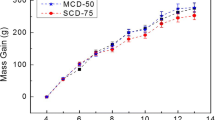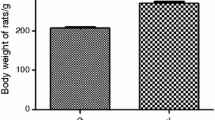Summary
A particular strain of rat, the osteogenic disorder rat (ODS rat), was established in 1973. Phenotypic expression of od/od in ODS rat develops signs characteristic of a vitamin C-deficient animal, with bleeding tendencies and limb fractures. We investigated the bone histomorphometry to clarify the pathogenesis of osteopathy found in ODS rat. Bone histomorphometry revealed that static parameters reflecting bone formation were found to be remarkably decreased in od/od rats. These observations were more prominent in the metaphysis of distal femurs of od/od rats than those in the tail vertebrae. Parameters reflecting bone resorption in od/od rats were reduced in the distal femoral metaphysis, but were similar to those of controls in the tail vertebrae. These parameters were restored to control levels after ascorbic acid supplementation to pair-fed od/od rats. The mineral appositional rate in od/od rats was not significantly different from that in controls. Although body weight gain in pair-fed controls was significantly reduced compared to those fedad libitum, histomorphometric parameters, on the contrary, were unaltered between these groups. Our present study provides evidence that the cause of osteopenia found in od/od rat is attributable to an imbalance between the total amounts of resorption and formation, and the pathogenesis of osteopathy could be due to ascorbic acid deficiency itself rather than malnutrition.
Similar content being viewed by others
References
Mizushima Y, Harauchi T, Yoshizaki T, Makino S (1984) A rat mutant unable to synthesize vitamin C. Experientia 40:359–361
Horio F, Ozaki K, Yoshida A, Makino S, Hayashi Y (1985) Requirement for ascorbic acid in a rat mutant unable to synthesize ascorbic acid. J Nutr 115:1630–1640
Gitelman HJ (1967) An improved automated procedure for the determination of calcium in biological specimens. Anal Biochem 18:521–531
Lowry OH, Lopez JA (1946) The determination of inorganic phosphate in the presence of labile phosphate esters. J Biol Chem 162:421–428
Bessey OA, Lowry OH, Brock MJ (1946) A method for the rapid determination of alkaline phosphatase with five cubic millimeters of serum. J Biol Chem 164:321–329
Kalu DN, Hardin RH, Cockerham R, Yu BP (1984) Aging and dietary modulation of rat skeleton and parathyroid hormone. Endocrinology 115:1239–1247
Roth M (1973) Column chromatography of amino acids with fluorescence detection. J Chromatogr 83:353–356
Baylink D, Stauffer M, Wergedal J, Rich R (1970) Formation, mineralization, and resorption of bone in vitamin D-deficient rats. J Clin Invest 49:1122–1134
Ueno K, Haba T, Woodbury D, Price P, Anderson R, Lee WSS (1985) The effects of prostaglandin E2 in rapidly growing rats: depressed longitudinal and radial growth and increased metaphyseal hard tissue mass. Bone 6:79–86
Kimmel DB, Jee WSS (1980) A quantitative histologic analysis of the growing long bone metaphysis. Calcif Tissue Int 32:113–122
Posner AS (1985) The mineral of bone. Clin Orthop 200:87–99
Boskey AL (1981) Current concepts of the physiology and biochemistry of calcification. Clin Orthop 157:225–257
Fisher LW, Termine JD (1985) Noncollagenous protein influencing the local mechanisms of calcification. Clin Orthop 200:362–385
Glimcher MJ (1976) Composition, structure and organization of bone and other mineralized tissues and the mechanism of calcification. In: Greep RO, Astwood EB (eds) Handbook of physiology-endocrinology. Williams and Wilkins, Baltimore, p 25
Chen TL, Raisz LG (1975) The effects of ascorbic acid deficiency on calcium and collagen metabolism in cultured fetal rat bones. Calcif Tissue Res 17:113–127
Sodek J, Feng J, Yen EHK, Melcher AH (1982) Effect of ascorbic acid on protein synthesis and collagen hydroxylation in continuous flow organ cultures of adult mouse periodontal tissues. Calcif Tissue Int 34:408–415
Murad S, Grove D, Lindberg KA, Reynolds G, Sivarajah A, Pinnell SR (1981) Regulation of collagen synthesis by ascorbic acid. Proc Natl Acad Sci USA 78:2879–2882
Rodan GA, Rodan SB (1984) Expression of the osteoblastic phenotype. In: Peck WA (ed) Bone and mineral research, Ann 2. Elsevier, Amsterdam p 244
Author information
Authors and Affiliations
Rights and permissions
About this article
Cite this article
Tsunenari, T., Fukase, M. & Fujita, T. Bone histomorphometric analysis for the cause of osteopenia in vitamin C-deficient rat (ODS rat). Calcif Tissue Int 48, 18–27 (1991). https://doi.org/10.1007/BF02555792
Received:
Revised:
Issue Date:
DOI: https://doi.org/10.1007/BF02555792




